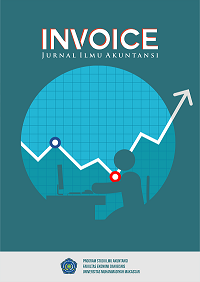Comparisonal Analysis Of Debt To Equity Ratio (DER) Between Pt. Bank Mega, Tbk And Pt. Bank CIMB Niaga, Tbk
DOI:
https://doi.org/10.26618/inv.v4i2.7805Abstract
This study aims to determine whether there are differences in the Debt To Equity Ratio (DER) between PT. Bank Mega, TBK and PT. Bank CIMB Niaga, TBK. The data used in this study is quantitative data from secondary data sources which are then processed. This type of research is comparative, comparative research is used to determine the difference in Debt To Equity Ratio (DER) between PT. Bank Mega, TBK and PT. Bank CIMB Niaga, TBK. The research instrument used is a list of tables containing data on total debt and total equity of PT. Bank Mega, TBK and PT. Bank CIMB Niaga, TBK. The population used in this study were all financial statements of PT. Bank Mega, TBK since being listed on the IDX from 1969 to 2020 for 51 years and PT. Bank CIMB Niaga, TBK since being listed on the IDX from 1989 to 2020, which is 31 years. The sample in this study is the financial statements of PT. Bank Mega, TBK and PT.Bank CIMB Niaga, TBK for 10 years, from 2011 to 2020. The sampling technique used in this study is a purposive sampling technique with the criteria (1) financial statement data is available for 10 consecutive years namely the years 2011-2020 (2) the 10-year sample data already represents the existing population data for research needs. Data collection techniques used are documentation and literature study. The data analysis technique used in this research is descriptive analysis and statistical analysis using independent sample t test. The results showed that there was no difference in Debt to Equity Ratio (DER) between PT. Bank Mega, TBK and PT. Bank CIMB Niaga, TBK.
References
Aprilitas, I., Tcandrakirana, R., Asphani, H. 2013. “Analisis Perbandingan Kinerja Keuangan Perusahaan Sebelum Dan Sesudah Akuisisi (Study Pada Perusahaan Pengakuisisi Yang Terdaftar Di Bei Periode 2000-2011).” Jurnal Manajemen dan Bisnis Sriwijaya 11(2): 99–114.
Arikunto, S. 2016. Prosedur Penelitian Suatu Pendektan Praktik. Jakarta: Rineka Cipta.
Darmadji, T. D. 2013. Pasar Modal Di Indonesia. Jakarta: Selemba Empat.
Doerachman, D., Tommy, P., and Rate, P.V. 2016. “Analisis Perbandingan Kinerja Keuangan Pada Perusahaan Farmasi Yang Terdaftar Di Bursa Efek Indonesia Periode 2011-2014.” Jurnal Berkala Ilmiah Efisiensi 16(3): 27–37.
Fahmi, I. 2013. Pengantar Manajemen Keuangan. Bandung: Alfabeta.
Marbelanty, V., Adityawarman. 2019. “Analisis Perbandingan Kinerja Keuangan Antara Perbankan Konvensional Dengan Perbankan Syariah Di Indonesia.” Journal Of Accounting 3(No. 1): 1–10.
Kasmir. 2016. Analisis Laporan Keuangan. Jakarta: Raja Grafindo Persada.
Marthalova, R. A., and Ngatno. 2018. “Analisi Pengaruh Debt to Equity Ratio (DER) Terhadap Price to Book Value( Pbv) Dengan Return on Equity (Roe) Sebagai Variabel Intervening (Studi Kasus Pada Perusahaan Indeks LQ45 Yang Terdaftar Di Bursa Efek Indonesia Tahun 2013-2016.” Jurnal Ilmu Administrasi Bisnis 7(3): 132–41. https://ejournal3.undip.ac.id/index.php/jiab/article/view/20939.
Mujabir, Pratiwi, A. 2021. “Analisis Perbandingan Debt To Equity Ratio Antarakalbe Farma Tbk Dan Pt Kimia Farma Tbk.” JUIMA:Jurnal Ilmu Manajemen 11(2): 1–6.
Ratnanggadi, A.C., Laksana, B., Hermawan, D. 2021. “Analisis Perbandingan Kinerja Keuangan Pada PT Aneka Gas Industri Tbk S ebelum Dan Sesudah Go Public Comparative Analysis of Financial Performance PT Aneka Gas Industri Tbk before and after Going Public.” Indonesian Journal of Economics and Management 1(2): 257–67.
Rohana, S., Pratiwi, A. 2020. “Analisis Perbandingan Degree Of Financial Leverage Antara Bank Cimb Niaga Dan Bank Danamon.” Jurnal Riset Akuntansi dan Keuangan Dewantara 3(1): 28–34. http://ejournal.stiedewantara.ac.id/index.php/JAD/issue/view/49.
Sugiyono. 2016. Bandung: Alfabeta Metode Penelitian Kuantitatif Kualitatif Dan R&D.
Downloads
Published
Issue
Section
License
Authors who publish with Invoice: Jurnal Ilmu Akuntansi agree to the following terms:
Copyright Ownership
The copyright of all articles published in this journal remains with the author(s). However, the authors grant Invoice: Jurnal Ilmu Akuntansi the right of first publication with the work simultaneously licensed under a Creative Commons Attribution 4.0 International License (CC BY 4.0). This license allows others to share, copy, redistribute, adapt, and build upon the work for any purpose, even commercially, as long as proper credit is given to the original author(s) and the source.Licensing and Access
Invoice: Jurnal Ilmu Akuntansi provides immediate open access to its content on the principle that making research freely available to the public supports a greater global exchange of knowledge. All published materials are available freely without subscription or payment and can be accessed, downloaded, and reused by any user provided that appropriate attribution is given.Permission for Reuse
For uses not covered by the CC BY 4.0 license, such as commercial reprints, translations, or any form of adaptation without clear attribution, users must obtain written permission from the editorial team. Requests for such permissions can be directed to the editorial office at: [insert journal email here].Plagiarism and Originality
Authors are responsible for the originality of their submissions. All articles are screened for plagiarism using appropriate tools before acceptance. Manuscripts found to contain unoriginal content or infringing materials will be rejected or retracted as per journal policy.

